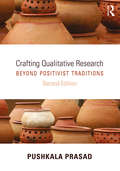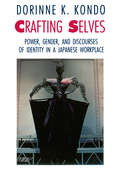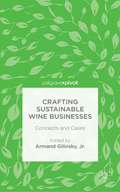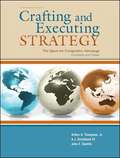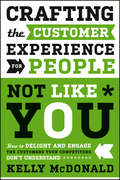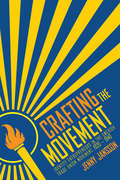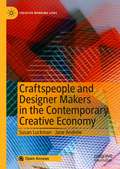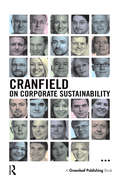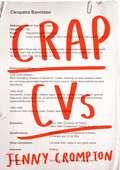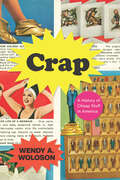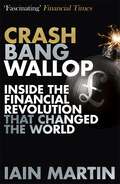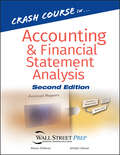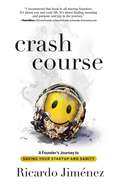- Table View
- List View
Crafting Policies to End Poverty in Latin America
by Ana Lorena De La OThis book provides a theory and evidence to explain the initial decision of governments to adopt a conditional cash transfer program (the most prominent type of antipoverty program currently in operation in Latin America), and whether such programs are insulated from political manipulations or not. Ana Lorena De La O shows that whether presidents limit their own discretion or not has consequences for the survival of policies, their manipulation, and how effective they are in improving the lives of the poor. This book is the first of its kind to present evidence from all Latin American CCTs.
Crafting Qualitative Research: Beyond Positivist Traditions
by Pushkala PrasadThis book provides an overview of qualitative research models and their applications in organization and management studies. Focusing on the philosophical underpinnings and practical implications of diverse qualitative methods, this comprehensive text offers a guided tour of the options available to qualitative researchers, highlighting aspects of research design, execution, and analysis in each tradition. In clear, readable prose, the author offers insight into the ambiguities, tensions, and interconnections of diverse qualitative research traditions without resorting to oversimplification. The book’s four main sections include examples and applications specifically designed for the field of management. Each chapter is devoted to a specific methodology, describing techniques and applications as well as current controversies and emerging issues. Summary boxes and practical examples will help the reader to navigate this terrain and generate research that is both relevant and of high scholarly quality. With its detailed and easy-to-understand coverage, this will be the text of choice for students working with qualitative methods in organization studies, consumer research, public administration, information systems, and media and communication studies. Instructors teaching qualitative approaches in a research methods course and researchers wanting to acquaint themselves with non-positivist traditions will also find this a useful resource.
Crafting Selves
by Dorinne K. Kondo"The ethnography of Japan is currently being reshaped by a new generation of Japanologists, and the present work certainly deserves a place in this body of literature. . . . The combination of utility with beauty makes Kondo's book required reading, for those with an interest not only in Japan but also in reflexive anthropology, women's studies, field methods, the anthropology of work, social psychology, Asian Americans, and even modern literature. "—Paul H. Noguchi, American Anthropologist "Kondo's work is significant because she goes beyond disharmony, insisting on complexity. Kondo shows that inequalities are not simply oppressive-they are meaningful ways to establish identities. "—Nancy Rosenberger, Journal of Asian Studies
Crafting Strategic Architecture: Competing for the Future
by Gary Hamel C. K. PrahaladThis chapter shows you how to conquer the challenge of yesterday's foresight becoming today's conventional wisdom by building a strategic architecture that enables you to invest, again and again, in creating a prescient view of the future.
Crafting Strategy
by Henry MintzbergFormal planning alone is not the best way for managers to develop strategy. Facts, figures, and forecasts are necessary; but managers also need an intuitive understanding of the organization, a feel for the business not unlike a potter's feel for the clay. Strategy is not just a plan for the future but also a pattern out of the past. Strategies are not always deliberate--they also emerge over time as organizations innovate and respond to their markets. By seeing patterns take shape in their environments, the best strategists find strategies as well as create them. McKinsey Award Winner.
Crafting Strategy: Embodied Metaphors in Practice
by Loizos Heracleous Claus D. JacobsThe rationalist approach to strategizing emphasizes analytical and convergent thinking. Without denying the importance of this approach, this book argues that strategists must learn to complement it with a more creative approach to strategizing that emphasizes synthetic and divergent ways of thinking. The theoretical underpinnings of this approach include embodied realism, interpretivism, practice theory, theory of play, design thinking, as well as discursive approaches such as metaphorical analysis, narrative analysis, dialogical analysis and hermeneutics. The book includes in-depth discussions of these theories and shows how they can be put into practice by presenting detailed analyses of embodied metaphors built by groups of agents with step-by-step explanations of how this process can be implemented and facilitated. The link between theory and practice is further supported by the inclusion of several vignettes that describe how this approach has been successfully employed in a number of organizations, including BASF and UNICEF.
Crafting Sustainable Wine Businesses: Concepts and Cases
by Armand Gilinsky Jr.Sustainable wine businesses are being crafted around the world, leaving the land in better shape for the next generation. In this book, four case studies reveal that sustainability in the wine industry it is tied tightly to long-term profitability.
Crafting Tradition: The Making and Marketing of Oaxacan Wood Carvings
by Michael ChibnikSince the mid-1980s, whimsical, brightly colored wood carvings from the Mexican state of Oaxaca have found their way into gift shops and private homes across the United States and Europe, as Western consumers seek to connect with the authenticity and tradition represented by indigenous folk arts. Ironically, however, the Oaxacan wood carvings are not a traditional folk art. Invented in the mid-twentieth century by non-Indian Mexican artisans for the tourist market, their appeal flows as much from intercultural miscommunication as from their intrinsic artistic merit. In this beautifully illustrated book, Michael Chibnik offers the first in-depth look at the international trade in Oaxacan wood carvings, including their history, production, marketing, and cultural representations. Drawing on interviews he conducted in the carving communities and among wholesalers, retailers, and consumers, he follows the entire production and consumption cycle, from the harvesting of copal wood to the final purchase of the finished piece. Along the way, he describes how and why this "invented tradition" has been promoted as a "Zapotec Indian" craft and explores its similarities with other local crafts with longer histories. He also fully discusses the effects on local communities of participating in the global market, concluding that the trade in Oaxacan wood carvings is an almost paradigmatic case study of globalization.
Crafting a Career Narrative for New Professionals
by Heidi K. Gardner Adam ZaliskThis note suggests an approach for developing an effective "career narrative" - a tool for packaging and sharing a professional's past achievements, long-term goals, and forward-looking needs through a compelling story. It focuses mostly on the ways junior professionals can leverage their career story, but also consider what role more senior mentors can - and should - play in cultivating and sharing juniors' career narratives.
Crafting an Infrastructure for Innovation: The X-Team Program
by Deborah Ancona Henrik BresmanSuppose you are a CEO, or the director of a large division, or the head of human resources, or a manager in R&D, and you don't want to create just one high-performing X-team? What if you want to create a set of X-teams that create innovative products and ideas year after year and eventually reshape the way your organization functions? This calls for an X-team program-such as those developed at Merrill Lynch and BP.
Crafting and Executing Strategy: Concepts and Cases (17th Edition)
by Arthur A. Thompson John Gamble A. J. StricklandThompson, Strickland and Gambles', CRAFTING AND EXECUTING STRATEGY, 17e presents the latest research findings from the literature and cutting-edge strategic practices of companies have been incorporated to keep step with both theory and practice. The chapter content continues to be solidly mainstream and balanced, mirroring both the best academic thinking and the pragmatism of real-world strategic management. Known for its cases and teaching notes, CRAFTING AND EXECUTING STRATEGY, 17e provides an unparalleled case line up. (1) 22 of the 26 cases are brand new or extensively updated for this edition, (2) The selection of cases is diverse, timely, and thoughtfully-crafted and complements the text presentation pushing students to apply the concepts and analytical tools they have read about. (3) Many cases involve high-profile companies. (4) And there's a comprehensive package of support materials that are a breeze to use, highly effective, and flexible enough to fit most any course design.
Crafting and Shaping Knowledge Worker Services in the Information Economy: Capacity And Capability Building For Emerging Opportunities
by Bhuvan Unhelkar Keith SherringhamThis book offers a hands-on approach to prepare businesses for managing the impact of technology transformation by the pragmatic, consistent, and persistent application of proven business principles and practices. Technology is rapidly transforming our businesses and our society. Knowledge worker roles are being impacted, and as operations are being automated, business models are changing as the use of cloud-based services lowers costs and provides flexibility. This book provides a guide towards managing the environment of uncertainly caused by the rapid changes in technology by combining strategy and leadership to influence the environment, instil the right behaviours, and strengthen the skills that will enable businesses to be adaptive, responsive, and resilient.
Crafting the Customer Experience For People Not Like You
by Kelly McdonaldDeliver a better business experience, for every kind of customerA "one-size fits all" approach to customer service is no longer viable. Businesses competing on service need to understand and cater to customers' racial, ethnic, religious, generational, and geographic differences in order to meet or exceed customers' service expectations. Crafting the Customer Experience to People Not Like You shows how companies, brands, and products struggling to differentiate themselves in a sea of sameness can foster long-term loyalty and brand preference with exceptional and customized customer service. A detailed guide to core customer groups including women, the five generations (matures, Boomers, Gen X, Gen Y and Gen Z), racial and ethnic segments, such as Hispanics and African-Americans, as well as those who are defined by key lifestyle and life-stage attributesIncludes onsumer insights that will help business leaders deliver a better business experience with every customerYou cannot control the economy, the stock market or the costs of goods and labor. But you can control your organization's customer service. It's an empowering thought. Customer service is 100% in your control at all times and it's more important than ever.
Crafting the Movement: Identity Entrepreneurs in the Swedish Trade Union Movement, 1920–1940
by Jenny JanssonCrafting the Movement presents an explanation of why the Swedish working class so unanimously adopted reformism during the interwar period. Jenny Jansson discusses the precarious time for the labor movement after the Russian Revolution in 1917 that sparked a trend towards radicalization among labor organizations and communist organizations throughout Europe and caused an identity crisis in class organizations. She reveals that the leadership of the Trade Union Confederation (LO) was well aware of the identity problems that the left-wing factions had created for the reformist unions.Crafting the Movement explains how this led labor movement leaders towards a re-formulation of the notion of the worker by constructing an organizational identity that downplayed class struggle and embraced discipline, peaceful solutions to labor market problems, and cooperation with the employers. As Jansson shows, study activities arranged by the Workers' Educational Association became the main tool of the Trade Union Confederation's identity policy in the 1920s and 1930s and its successful outcome paved the way for the well-known "Swedish Model."Thanks to generous funding from Uppsala University, the ebook editions of this book are available as Open Access volumes from Cornell Open (cornellopen.org) and other Open Access repositories.
Craftspeople and Designer Makers in the Contemporary Creative Economy (Creative Working Lives)
by Susan Luckman Jane AndrewThis open access book explores the experience of working as a craftsperson or designer maker in the contemporary creative economy. The authors utilise evidence from the only major empirical study to explore the skills required and the challenges facing contemporary makers in an increasingly crowded marketplace. Drawing upon 180 interviews with peak organisations, established and emerging makers, and four years of fieldwork across Australia, this book offers a unique insight into the motivations informing those who seek to make an income from their craft or designer maker practice, as well as the challenges and opportunities facing them as they do so at this time of renewed interest internationally in the artisanal and handmade. Offering a rich and deep collection of real-life experiences, this book is aimed both at an academic and practitioner audience.
Craig Parks (A)
by David A. Thomas Lisa ChadderdonCraig Parks is a 1992 HBS graduate who, without much deliberation, returns to work for his former employer, Taylor Burton on Wall Street. The choice proves to be a poor fit for Craig. The case documents his decision-making process, personal history, and the dilemma he confronts once he realizes returning to Taylor Burton was the wrong decision.
Cranfield on Corporate Sustainability
by David GraysonBusiness schools have a special contribution to make in developing globally responsible, critical and independent-thinking future leaders and managers. In fact, the Cranfield School of Management acknowledges this as one of its important responsibilities. Its core ideology is to transform the practice of learning and create leaders who action their knowledge and become stewards of the common good. Such thinking forms the basis of this book and its theme of developing responsible and ethical leaders for next-generation enterprises. These leaders will be passionate, purposeful and responsible; their primary aim will be to make a difference in the lives of people and create sustainable value premised on sound ethical values. This book aims to provide a roadmap both for business students – the leaders of tomorrow – and for existing and engaged leaders who need support, coaching and counselling to address the challenges of the sustainability agenda. With contributions from more than thirty Cranfield faculty and associates across multiple management disciplines, the book emphasizes the need for cross-disciplinarity when confronting sustainability dilemmas. Many corporate responsibility practitioners find themselves isolated from core business issues. Conversely, many managers in traditional departments have little or no knowledge of what sustainability and corporate responsibility means to their day-to-day role. Today, there is an urgent need for learning, for conversation and for sustainability to become embedded throughout an organization's DNA. Cranfield strives to prepare its students for a work milieu that is increasingly complex, diverse, technologically interconnected, socially networked and where economic and political power shifts see emerging-market economies assuming significant global prominence. This makes for exciting challenges but also requires new mind-sets for the next generation of business men and women. Corporate responsibility, and the tough ethical and governance choices managers have to grapple with, where there are no easy answers, means that business education must embrace the stakeholder model. Leaders need to be able to negotiate their way with confidence around multiple perspectives and conflicting and common interests of stakeholders such as employees and managers, shareholders, trade unions, suppliers and civil society organisations. Business schools need to generate understanding of and sensitivity to this new and changing world of work. Today, the challenge for business schools and business itself is to establish a new maxim: "the business of business is sustainable business". Cranfield on Corporate Sustainability is designed to stimulate debate about what sustainable development means for business and, therefore, on what business schools across the globe should research, teach and advise. This unique book is a manifesto for a new holistic, embedded approach to corporate sustainability management education.
Crap CVs
by Jenny CromptonA HILARIOUS COMPILATION OF THE WORST JOB APPLICATIONS IMAGINABLE - A PERFECT STOCKING FILLER OR OFFICE SECRET SANTA GIFT THIS CHRISTMAS. Ever read a truly terrible job application? Or perhaps slightly exaggerated the truth on one of your own...We've all been there - but these are worse. So much worse. From overly-honest cover letters, embarrassing typos, and mortifying personal revelations, to awkward interview questions, misplaced self-confidence, and, of course, outright lies. This hilarious collection of shockingly dreadful job applications, crap CVs and excruciating interviews will have you laughing out loud, while also making you feel so much better about yourself - because at least you weren't ever this bad . . .Application for EmploymentI refer to the recent death of the Technical Manager at your company and hereby apply for the replacement of the deceased manager.Each time I apply for a job, I get a reply that there is no vacancy but in this case I have caught you red-handed and you have no excuse because I even attended the funeral to be sure that he was truly dead and buried before applying.Attached to my letter is a copy of my CV and his death certificate.The Interview:Q. Is there anything about this job that you feel you might not be very good at?A. Dealing with people.Q. What person, living or dead, would you most like to meet?A. The living one.
Crap: A History of Cheap Stuff in America
by Wendy A. WolosonCrap. We all have it. Filling drawers. Overflowing bins and baskets. Proudly displayed or stuffed in boxes in basements and garages. Big and small. Metal, fabric, and a whole lot of plastic. So much crap. Abundant cheap stuff is about as American as it gets. And it turns out these seemingly unimportant consumer goods offer unique insights into ourselves—our values and our desires. In Crap: A History of Cheap Stuff in America, Wendy A. Woloson takes seriously the history of objects that are often cynically-made and easy to dismiss: things not made to last; things we don't really need; things we often don't even really want. Woloson does not mock these ordinary, everyday possessions but seeks to understand them as a way to understand aspects of ourselves, socially, culturally, and economically: Why do we—as individuals and as a culture—possess these things? Where do they come from? Why do we want them? And what is the true cost of owning them? Woloson tells the history of crap from the late eighteenth century up through today, exploring its many categories: gadgets, knickknacks, novelty goods, mass-produced collectibles, giftware, variety store merchandise. As Woloson shows, not all crap is crappy in the same way—bric-a-brac is crappy in a different way from, say, advertising giveaways, which are differently crappy from commemorative plates. Taking on the full brilliant and depressing array of crappy material goods, the book explores the overlooked corners of the American market and mindset, revealing the complexity of our relationship with commodity culture over time. By studying crap rather than finely made material objects, Woloson shows us a new way to truly understand ourselves, our national character, and our collective psyche. For all its problems, and despite its disposability, our crap is us.
Crash Bang Wallop: The Inside Story of London's Big Bang and a Financial Revolution that Changed the World
by Iain MartinPublished to mark the 30th anniversary of the financial revolution known as 'Big Bang', Crash Bang Wallop will tell the gripping story of how the changes introduced in the 1980s in the City of London transformed our world.Attitudes to money and the way we measure value and status were completely reshaped by Big Bang, and it had an extraordinary impact on politics, on style, on technology, on the class system, on questions of public ownership, and on the geography of London. Perhaps more than anything, Big Bang revolutionised the international markets, as the capital became a testing ground for financial globalisation, with huge repercussions for the global economy. The definitive insider's account of this critically important moment in modern history, Crash Bang Wallop will also explore what's next for global finance as it gets ready to undergo yet another revolution. 'Iain Martin tells it brilliantly, mixing fury-inducing narrative with an acute eye for the broader conclusion.' Observer
Crash Bang Wallop: The Inside Story of London's Big Bang and a Financial Revolution that Changed the World
by Iain MartinPublished to mark the 30th anniversary of the financial revolution known as 'Big Bang', Crash Bang Wallop will tell the gripping story of how the changes introduced in the 1980s in the City of London transformed our world.Attitudes to money and the way we measure value and status were completely reshaped by Big Bang, and it had an extraordinary impact on politics, on style, on technology, on the class system, on questions of public ownership, and on the geography of London. Perhaps more than anything, Big Bang revolutionised the international markets, as the capital became a testing ground for financial globalisation, with huge repercussions for the global economy. The definitive insider's account of this critically important moment in modern history, Crash Bang Wallop will also explore what's next for global finance as it gets ready to undergo yet another revolution. 'Iain Martin tells it brilliantly, mixing fury-inducing narrative with an acute eye for the broader conclusion.' Observer(P)2016 Hodder & Stoughton
Crash Bang Wallop: The Inside Story of Londons Big Bang and a Financial Revolution that Changed the World
by Iain MartinPublished to mark the 30th anniversary of the financial revolution known as 'Big Bang', Crash Bang Wallop will tell the gripping story of how the changes introduced in the 1980s in the City of London transformed our world.Attitudes to money and the way we measure value and status were completely reshaped by Big Bang, and it had an extraordinary impact on politics, on style, on technology, on the class system, on questions of public ownership, and on the geography of London. Perhaps more than anything, Big Bang revolutionised the international markets, as the capital became a testing ground for financial globalisation, with huge repercussions for the global economy. The definitive insider's account of this critically important moment in modern history, Crash Bang Wallop will also explore what's next for global finance as it gets ready to undergo yet another revolution. 'Iain Martin tells it brilliantly, mixing fury-inducing narrative with an acute eye for the broader conclusion.' Observer
Crash Course in Accounting and Financial Statement Analysis
by Matan Feldman Arkady LibmanSeamlessly bridging academic accounting with real-life applications, Crash Course in Accounting and Financial Statement Analysis, Second Edition is the perfect guide to a complete understanding of accounting and financial statement analysis for those with no prior accounting background and those who seek a refresher.
Crash Course: A Founder's Journey to Saving Your Startup and Sanity
by Ricardo JiménezIn Crash Course, Ricardo Jiménez recounts his personal startup failure so that other entrepreneurs and business founders may learn from his mistakes as they chase their own business dreams.Nine times out of ten, the passionate, well-educated, semi-cocky entrepreneur with dreams of taking the market by storm . . . fails. Whether it&’s a quick crash and burn within the first year or a longer struggle over several years, the result is usually the same: an exhausted, confused, financially broke, and emotionally broken startup failure. We love to hear stories of lean-and-mean startups that bootstrap their way to a hard-fought victory. But what about the other 90 percent? What about the startup founders who were chewed up and spit out by potential investors, dirty-dealing partners, and fickle customers? What about the ones who dared to give their dream wings . . . only to watch it crash on the runway? Don&’t we have as much or more to learn from them as we do the lucky few who actually make it? In Crash Course, entrepreneur Ricardo Jimenez crawls out from under the wreckage of his failed startup and forces himself to explore how his best-laid plans went so terribly wrong. With surgical precision, Jiménez explores every decision, meeting, step, and misstep that turned his once-promising international toy company into an expensive lesson in how not to succeed in the highly competitive global marketplace. Putting pride aside, Jiménez puts his whole story on display—the good, the bad, and the terrible—with the hope that the next generation of startup entrepreneurs can learn from his mistakes and take a pain-free shortcut to the important lessons he had to learn the hard way.

